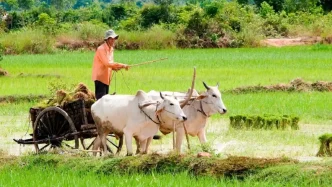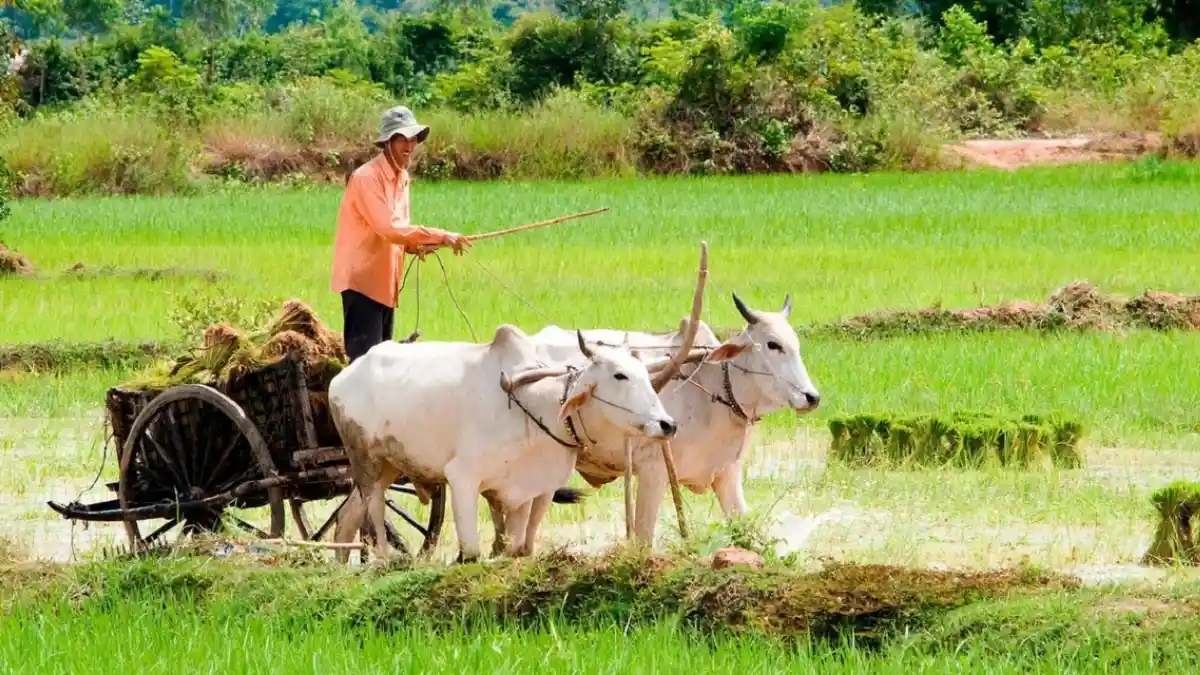In Cambodia’s northern Preah Vihear province, a surge of support for local farmers has emerged as supermarkets, government bodies, and influential business figures step in to buy hundreds of tonnes of pumpkins. This initiative, spurred by a border dispute with Thailand that has disrupted vegetable imports, reflects a broader national movement to bolster domestic agriculture and foster community solidarity. With over 400 tonnes of pumpkins already sold, the effort highlights both the challenges faced by rural farmers and the resilience of the “Khmer helping Khmer” spirit.
Border Dispute Fuels Local Market Drive
The catalyst for this agricultural support campaign is a simmering border conflict with Thailand, which escalated following a deadly exchange of fire on May 28 that claimed the life of a Cambodian soldier. In response, Cambodia halted imports of several goods from Thailand after the neighboring country unilaterally closed border crossings. The suspension of vegetable imports has left farmers in regions like Preah Vihear, who previously relied on cross-border trade, struggling to find markets for their produce.
Local authorities, alongside the provincial Department of Commerce and commune agriculture offices in Sangkum Thmei and Kulen districts, have scrambled to facilitate sales for farmers in Ro’ang and Phnom Tbeng I communes. According to the Ministry of Agriculture, Forestry and Fisheries, as of June 24, a total of 338 tonnes of pumpkins had been sold to major buyers, including Chip Mong Supermarket (146 tonnes), E-Gets Company (52 tonnes), Aeon Mall (46 tonnes), Makro (28 tonnes), Samdech Techo Foundation communities (20 tonnes), and Vireak Bunthang Company (15 tonnes). Reports from commune agricultural officer Em Theara indicate that the figure has since risen to over 400 tonnes by June 25.
“Private companies, supermarkets, and philanthropists are continuing to purchase them for resale or charity purposes. Our goal is to help the farmers. We’re buying from them at reasonable prices to ensure they are satisfied” said Theara in an interview with a local outlet. Current purchase prices range from 200 to 300 Cambodian Riel per kilogram (approximately US$0.05 to US$0.07), though with over 2,000 tonnes of pumpkins still unsold, the need for additional market channels remains urgent.
Community and Corporate Support Steps In
Amid the economic strain caused by the border closure, a wave of solidarity has swept through Cambodian society. Prominent business figures, known as Okhnas, have joined the effort to support Preah Vihear’s farmers. Okhna Srey Chanthorn, for instance, purchased over 30 tonnes of pumpkins to distribute free of charge to the public. Announcing the initiative on social media, Chanthorn stated, “Right now, four tonnes of naturally grown pumpkins from our brothers and sisters in Preah Vihear have arrived at 9NG Amusement Garden. Any visitors to the garden will receive pumpkins free of charge. An additional 30 tonnes are on the way. Khmer helping Khmer, Support Khmer products.”
This sentiment of national unity has been echoed at the highest levels of government. During the closing ceremony of the Central Committee meeting of the Union of Youth Federations of Cambodia (UYFC) earlier this week, Prime Minister Hun Manet urged citizens to support local agricultural products. “Lately, there’s been a movement to support Khmer products. I’ve seen people post that Chip Mong bought pumpkins from our fellow citizens… there’s support through online purchases too. This is the Khmer spirit—Khmer helping Khmer during difficult times” said the Prime Minister. He also cautioned against price gouging, encouraging fair trade practices and increased local production to meet domestic demand.
Similarly, Senate President Hun Sen called on citizens to buy and donate local fruits and vegetables to frontline soldiers and orphanages, framing the act as both a patriotic duty and a means of supporting vulnerable communities. These high-profile endorsements have amplified the campaign, turning a local agricultural crisis into a national cause.
Challenges for Preah Vihear Farmers
Despite the outpouring of support, the scale of the challenge facing Preah Vihear’s farmers is daunting. With over 2,000 tonnes of pumpkins still awaiting buyers, logistical hurdles persist. Em Theara noted that many farmers rely on homemade tractors to transport their produce, but the limited number of buyers restricts their ability to offload stock quickly. “Farmers are transporting their pumpkins to sell on many homemade tractors, but the buyers are limited” he said.
The border dispute has compounded these difficulties. Preah Vihear, a rural province near the Thai border, has historically depended on cross-border trade to sustain its agricultural economy. The suspension of imports from Thailand, while intended as a retaliatory measure, has inadvertently created a surplus of perishable goods like pumpkins, which risk spoilage if not sold promptly. The current purchase prices, though described as “reasonable” by local officials, remain low, offering farmers slim margins to cover production costs.
Beyond pumpkins, the broader agricultural sector in Cambodia faces similar pressures. The border closure has disrupted supply chains for a range of vegetables and goods, forcing farmers across the country to seek alternative markets. While the immediate focus in Preah Vihear is on clearing the pumpkin surplus, the longer-term question is whether domestic demand can sustainably absorb the volume of produce previously destined for export or cross-border trade.
Economic and Political Implications
The push to support local farmers in Preah Vihear is more than a temporary relief effort; it underscores deeper economic and political currents in Cambodia. The border dispute with Thailand, rooted in historical territorial disagreements and exacerbated by the recent violent clash, has heightened nationalistic sentiments. By framing the purchase of local produce as an act of patriotism, Cambodian leaders are tapping into a narrative of self-reliance and resilience in the face of external challenges.
Economically, the initiative reflects a broader ambition to reduce Cambodia’s dependence on imported goods and strengthen domestic agricultural production. This aligns with government policies aimed at boosting rural economies, which form the backbone of the country’s workforce. According to data from the World Bank, agriculture accounts for roughly 22% of Cambodia’s GDP and employs a significant portion of its population, particularly in provinces like Preah Vihear. Supporting farmers through direct purchases by supermarkets and institutions could serve as a model for future interventions, though scaling such efforts nationwide would require substantial investment in infrastructure and market access.
Politically, the border tensions with Thailand add a layer of complexity. While the Cambodian government has used the situation to rally public support for local products, the ongoing dispute risks further economic fallout if unresolved. Trade disruptions along the border affect not only farmers but also broader bilateral relations, with potential implications for regional stability in Southeast Asia. Analysts suggest that both countries may need to de-escalate tensions through diplomatic channels to restore normalcy, though no immediate resolution appears in sight.
A Test of National Solidarity
The campaign to support Preah Vihear’s farmers also serves as a litmus test for Cambodia’s social cohesion. The involvement of diverse actors—from corporate giants like Chip Mong and Aeon Mall to individual philanthropists like Okhna Srey Chanthorn—demonstrates a collective willingness to address rural hardship. Yet, the disparity between the volume of unsold produce and the capacity of current buyers highlights the limits of ad hoc solutions.
For the farmers themselves, the immediate priority is survival. The low purchase prices, while better than no sales at all, underscore the vulnerability of small-scale agriculture in the face of geopolitical disruptions. As Em Theara emphasized, expanding market channels is critical to ensuring that the remaining 2,000 tonnes of pumpkins do not go to waste. Initiatives like Chanthorn’s free distribution at 9NG Amusement Garden offer a creative outlet, but they are unlikely to address the full scope of the surplus.
Looking Ahead: Sustainability and Resilience
As Cambodia navigates the fallout from its border dispute with Thailand, the plight of Preah Vihear’s farmers offers a window into the broader challenges facing the nation’s rural economy. The “Khmer helping Khmer” ethos, championed by leaders and citizens alike, has provided a lifeline to hundreds of farmers, with over 400 tonnes of pumpkins sold in a matter of weeks. Yet, with thousands of tonnes still unsold, the road ahead remains uncertain.
The government’s call for increased local production and consumption could mark a turning point, provided it is backed by policies to improve agricultural infrastructure and market access. For now, the resilience of Preah Vihear’s farmers—and the solidarity of those supporting them—stands as a testament to Cambodia’s determination to weather both economic and political storms. As tensions with Thailand persist, the question remains whether this spirit of unity can translate into lasting solutions for the country’s rural heartlands.
















